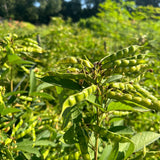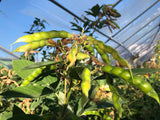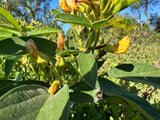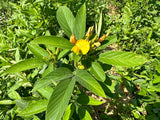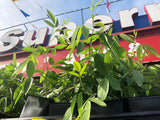Large, abundant, green-fruited pigeon peas adapted to growing in northern latitudes.
We first found this particular pigeon pea (gandules) variety for sale as plants at the Fine Fare Supermarket.
We grew a few plants and to our pleasant surprise, they produced beautifully and abundantly here in Philadelphia, and are distinct from our other Northern Adapted Pigeon Pea (Gandules) variety that we've been carrying in the catalog for many years. To learn the story behind this variety, we called the wholesaler’s phone number that was on the supermarket plant cart, which came from the Philadelphia Produce Market. They told us they get all their plants from Levari Farm Market in New Jersey. Here’s what Jim Levari told us:
The seeds were brought north by Puerto Rican farm workers and shared with Jim, who hired them on his South Jersey vegetable farm in his mid-20s. He’s 70 now, and grows them for his nursery, alongside other Puerto Rican specialties like Aji Dulce, Recao (Culantro), Rue, and lots of other veggies and flowers. He’s kept them because of their unique short season! H
Thanks to Jim for keeping these seeds all these years, to the Puerto Rican farmers who brought them north, and to all that came before them who shaped and nurtured this variety.
Days to maturity: 120
Seeds per pack: 15
Germination rate: 80% on 01/21/2025
Planting / harvesting notes
Plants can be direct sown around or shortly after last frost (end of May or early June in Brooklyn) or sown in the greenhouse 4-6 weeks earlier and transplanted after last frost. We use 1-2' spacing in row, in rows that are 2' apart. Plants grow slowly but eventually reach around 4' tall! They form a main stem that is woody and sturdy, not requiring trellising or support. In Brooklyn, our plants began flowering in late summer and we harvested pods incrementally as they turned brown and dry throughout September and October. If you want to harvest for fresh eating, you can harvest the pods when they are green and plump, though you may want to let some early pods mature for seeds to select for early maturity.
Seed keeping notes
Harvest seeds when pods have dried and turned crispy brown. Watch for caterpillars that eat through the seed pods, consuming the seeds. When the pods are fully dried, shell the seeds and allow them to dry further in a ventilated, dry, dark room.
Collections
This product is part of the
African Diaspora Collection.






